Muhammad Fahad
CSTB
Utilizing AI and Machine Learning for Predictive Analysis of Post-Treatment Cancer Recurrence
Feb 20, 2025Abstract:In oncology, recurrence after treatment is one of the major challenges, related to patients' survival and quality of life. Conventionally, prediction of cancer relapse has always relied on clinical observation with statistical model support, which almost fails to explain the complex, multifactorial nature of tumor recurrence. This research explores how AI and ML models may increase the accuracy and reliability of recurrence prediction in cancer. Therefore, AI and ML create new opportunities not only for personalized medicine but also for proactive management of patients through analyzing large volumes of data on genetics, clinical manifestations, and treatment. The paper describes the various AI and ML techniques for pattern identification and outcome prediction in cancer patients using supervised and unsupervised learning. Clinical implications provide an opportunity to review how early interventions could happen and the design of treatment planning.
* 15 pages
Estimation in the Gaussian Multiplex Channel
Dec 19, 2024Abstract:An abstraction for multisensor communication termed the Gaussian Multiplex Channel is presented and analyzed. In this model, the sensor outputs can be added together in any combination through a network of switches, and the combinations can be changed arbitrarily during the observation interval. The sensor output sums are observed in additive Gaussian noise. Using a mean square error cost function and a constraint on the total observation time, an optimal set of combinations (switch positions) and observation times is determined. The solution exhibits high complexity (number of different combinations) even for moderate numbers of sensors. It is then shown that there exists an alternative solution based on Hadamard designs, which achieves the same minimizing MSE cost function and only requires a number of combinations equal to the number of sensors.
Heuristic Sensing Schemes for Four-Target Detection in Time-Constrained Vector Poisson and Gaussian Channels
Feb 21, 2022

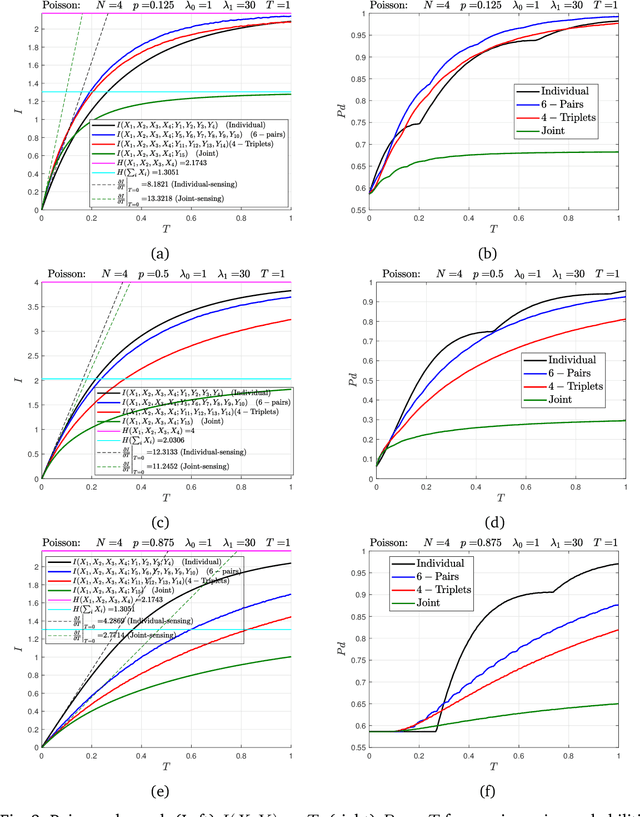

Abstract:In this work, we investigate the different sensing schemes for the detection of four targets as observed through a vector Poisson and Gaussian channels when the sensing time resource is limited and the source signals can be observed through a variety of sum combinations during that fixed time. For this purpose, we can maximize the mutual information or the detection probability with respect to the time allocated to different sum combinations, for a given total fixed time. It is observed that for both Poisson and Gaussian channels; mutual information and Bayes risk with $0-1$ cost are not necessarily consistent with each other. Concavity of mutual information between input and output, for certain sensing schemes, in Poisson channel and Gaussian channel is shown to be concave w.r.t given times as linear time constraint is imposed. No optimal sensing scheme for any of the two channels is investigated in this work.
* 18 pages, 26 figures
Sensing Method for Two-Target Detection in Time-Constrained Vector Gaussian Channel
Feb 05, 2022Abstract:This paper considers a vector Gaussian channel of fixed identity covariance matrix and binary input signalling as the mean of it. A linear transformation is performed on the vector input signal. The objective is to find the optimal scaling matrix, under the total time constraint, that would: i) maximize the mutual information between the input and output random vectors, ii) maximize the MAP detection. It was found that the two metrics lead to different optimal solutions for our experimental design problem. We have used the Monte Carlo method for our computational work.
* 14 pages, 28 figures, journal article. arXiv admin note: text overlap with arXiv:2201.07915
Sensing Method for Two-Target Detection in Time-Constrained Vector Poisson Channel
Jan 19, 2022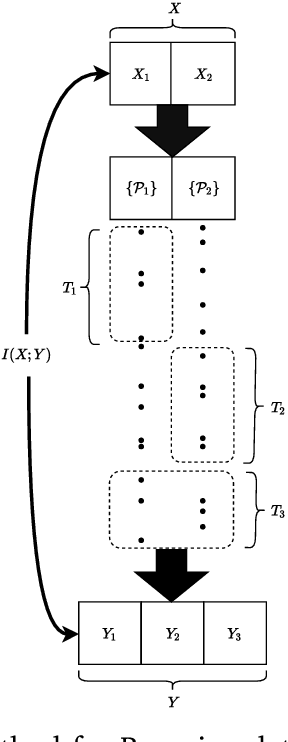
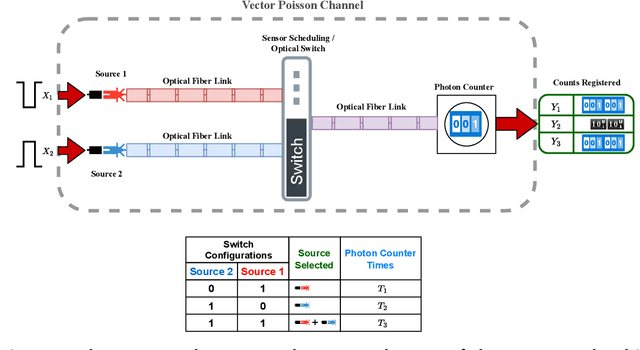
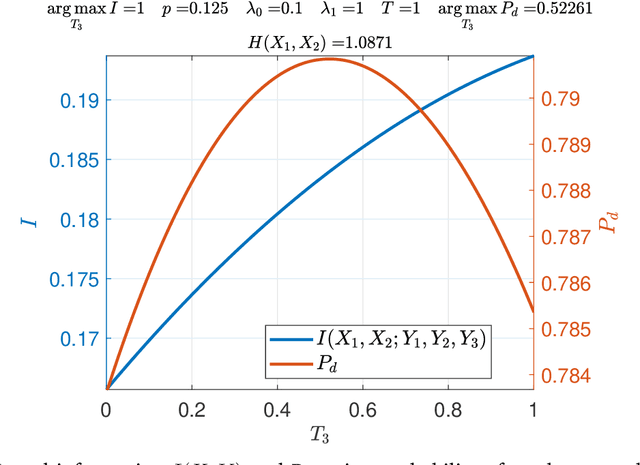
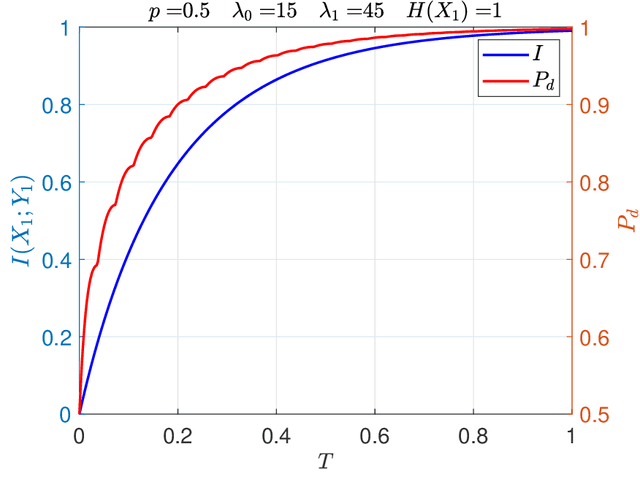
Abstract:It is an experimental design problem in which there are two Poisson sources with two possible and known rates, and one counter. Through a switch, the counter can observe the sources individually or the counts can be combined so that the counter observes the sum of the two. The sensor scheduling problem is to determine an optimal proportion of the available time to be allocated toward individual and joint sensing, under a total time constraint. Two different metrics are used for optimization: mutual information between the sources and the observed counts, and probability of detection for the associated source detection problem. Our results, which are primarily computational, indicate similar but not identical results under the two cost functions.
* 24 pages, 37 figures, journal article
Towards French Smart Building Code: Compliance Checking Based on Semantic Rules
Oct 01, 2019

Abstract:Manually checking models for compliance against building regulation is a time-consuming task for architects and construction engineers. There is thus a need for algorithms that process information from construction projects and report non-compliant elements. Still automated code-compliance checking raises several obstacles. Building regulations are usually published as human readable texts and their content is often ambiguous or incomplete. Also, the vocabulary used for expressing such regulations is very different from the vocabularies used to express Building Information Models (BIM). Furthermore, the high level of details associated to BIM-contained geometries induces complex calculations. Finally, the level of complexity of the IFC standard also hinders the automation of IFC processing tasks. Model chart, formal rules and pre-processors approach allows translating construction regulations into semantic queries. We further demonstrate the usefulness of this approach through several use cases. We argue our approach is a step forward in bridging the gap between regulation texts and automated checking algorithms. Finally with the recent building ontology BOT recommended by the W3C Linked Building Data Community Group, we identify perspectives for standardizing and extending our approach.
Ocean Plume Tracking with Unmanned Surface Vessels: Algorithms and Experiments
Apr 23, 2018



Abstract:Pollution plume monitoring using autonomous vehicles is important due to the adverse effect of pollution plumes on the environment and associated monetary losses. Using the advection-diffusion plume dispersion model, we present a control law design to track dynamic concentration level curves. We also present a gradient and divergence estimation method to enable this control law from concentration measurement only. We then present the field testing results of the control law to track concentration level curves in a plume generated using Rhodamine dye as a pollution surrogate in a near-shore marine environment. These plumes are then autonomously tracked using an unmanned surface vessel equipped with fluorometer sensors. Field experimental results are shown to evaluate the performance of the controller, and complexities of field experiments in real-world marine environments are discussed in the paper.
BPCMont: Business Process Change Management Ontology
Feb 13, 2016



Abstract:Change management for evolving collaborative business process development is crucial when the business logic, transections and workflow change due to changes in business strategies or organizational and technical environment. During the change implementation, business processes are analyzed and improved ensuring that they capture the proposed change and they do not contain any undesired functionalities or change side-effects. This paper presents Business Process Change Management approach for the efficient and effective implementation of change in the business process. The key technology behind our approach is our proposed Business Process Change Management Ontology (BPCMont) which is the main contribution of this paper. BPCMont, as a formalized change specification, helps to revert BP into a consistent state in case of system crash, intermediate conflicting stage or unauthorized change done, aid in change traceability in the new and old versions of business processes, change effects can be seen and estimated effectively, ease for Stakeholders to validate and verify change implementation, etc.
DKP-AOM: results for OAEI 2015
Oct 06, 2015


Abstract:In this paper, we present the results obtained by our DKP-AOM system within the OAEI 2015 campaign. DKP-AOM is an ontology merging tool designed to merge heterogeneous ontologies. In OAEI, we have participated with its ontology mapping component which serves as a basic module capable of matching large scale ontologies before their merging. This is our first successful participation in the Conference, OA4QA and Anatomy track of OAEI. DKP-AOM is participating with two versions (DKP-AOM and DKP-AOM_lite), DKP-AOM performs coherence analysis. In OA4QA track, DKPAOM out-performed in the evaluation and generated accurate alignments allowed to answer all the queries of the evaluation. We can also see its competitive results for the conference track in the evaluation initiative among other reputed systems. In the anatomy track, it has produced alignments within an allocated time and appeared in the list of systems which produce coherent results. Finally, we discuss some future work towards the development of DKP-AOM.
 Add to Chrome
Add to Chrome Add to Firefox
Add to Firefox Add to Edge
Add to Edge